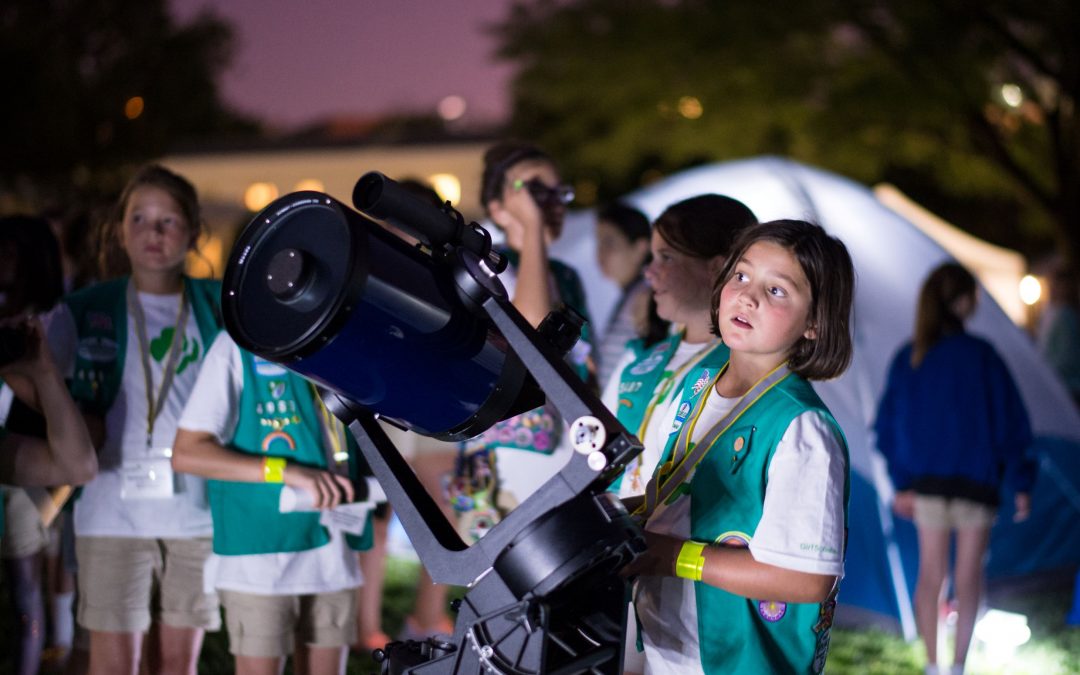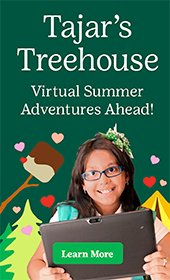What is one of your favorite Moon memories?
Whoever we are, wherever we’re from, each of us has our own associations with the Moon, Sun, and stars. Observing the universe around us and making meaning from what we see are a part of being human! Space Science badges tap into girls’ inherent curiosity, engage their sense of wonder, and offer opportunities to practice science skills along the way.
These badges, funded by Reaching for the Stars: NASA Science for Girl Scouts, were developed by GSUSA alongside the SETI Institute, Astronomical Society of the Pacific, Girl Scouts of Northern California, and other subject matter experts.
Save it for later!
I’m new to space science. Where do I start?
Welcome—we’re glad you are here! The activity options in your badge book are fully pilot-tested and ready to put into action. Looking for guidance and support? Interested in working with others on bringing these badges to life? We’ve got you covered. Visit the Night Sky Network for badge leadership advice and best practices. For community connections, browse GSNorCal’s astronomy events, clubs, and field trips.
Why space science badges for younger girls?
The youngest Girl Scouts are still forming their STEM identities. If you consistently see yourself as either “a science person” or “not a science person”, you are in good company! Most of us identify with one or the other of these categories at an early age. As a progression across all age levels, Space Science badges are designed to help build STEM confidence and support lifelong interest in exploring the mysteries of the universe.
For Daisies: Space Science Explorer badge
Explore and observe the sky like a real space scientist.
Daisies are on a mission to explore the Sun, observe the Moon, and meet the stars. This badge invites girls to record and compare observations over time, make and use simple tools to help them investigate their surroundings, and use their creativity to interpret the world around them.
For Brownies: Space Science Adventurer badge
Investigate the complexities of the sky as you learn to see things in a new way.
Space Science Adventurers have fun getting to know the planets in our solar system, trying new physical and virtual observing tools, experimenting with Moon phase models (cookie art, anyone?), and more!
For Juniors: Space Science Investigator badge
Venture through the Solar System and beyond, and see that space is even bigger than you may have imagined.
How old would you be if you counted your birthdays on Mercury? What might a familiar constellation look like from a distant, alien world? What if miniature planets were spread throughout your neighborhood? Imagination is an important part of our toolkit for exploring the cosmos. Space Science Investigators use their imaginations and other science practices to stretch their perspectives.
Connecting the Dots
In each set of badge activities, you’ll find ideas for collaboration and service. From Daisies showing others how to make a prediction, to Brownies helping Daisies to stargaze, to whole troops participating in public sky-watching parties, and beyond, Girl Scouts can build and join space science communities at many different scales.
Continuing the Journey
Space Science badges are available for all levels of Girl Scouts. For even more ways to pursue the science and story of space, try the following links. These programs and resources can help your Girl Scout(s) to complete badge steps—and to keep exploring!
Visit NASA’s Space Place for activities, features, and graphics designed especially for young space enthusiasts.
Love the Moon? Participate in International Observe the Moon Night, a worldwide, annual public event that brings together lunar observers and curious people around the world. (This event takes place in fall of each year, but activities and other resources are available year-round.)
Calling all citizen scientists! Would you like to help NASA measure light pollution in the night sky, understand Earth’s systems better, and more? Find a project to join here.
Discover solar system secrets with curated resource and activity packages focused on planets and moons including Saturn (and its moon Titan), Jupiter, Mars, Venus, and the outer solar system’s ocean worlds.
What’s Next:
- Discover more ways to explore the stars with Girl Scouts.
- Browse the JPL EDU library of ready-to-implement activities designed for all ages and stages.
- Space science is for everyone: check out the space science badges for older Girl Scouts!

Caela Barry—Caela works in the Solar System Exploration Division at NASA’s Goddard Space Flight Center. She writes website content, contributes to NASA’s social media accounts, helps to plan field research expeditions, and supports virtual public events like International Observe the Moon Night. Before joining the NASA team, Caela was an informal science educator.


